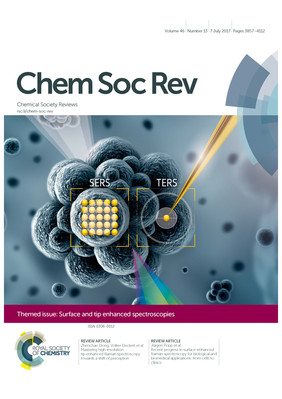Surface- and Tip-enhanced Raman-Spectroscopy on the Front Cover of Chemical Society Reviews

The research groups of Prof. Volker Deckert and Prof. Jürgen Popp have published three review articles in the current issue of the top-ranking journal Chemical Society Reviews. The contributions give a résumé of development and application of tip- and surface-enhanced Raman-spectroscopy as well as new theoretic and experimental concepts of this techniques.
Over the last 15 years, tip-enhanced Raman-spectroscopy (TERS) has established itself as an important analytical method for the analysis of inorganic, organic and biological material. Like no other method, the optical microscopy technique provides information on the chemical composition of an analyzed sample with such high sensitivity and a resolution on the nanometer scale. A general review about the relatively young technique originates from a cooperation with the University of Osaka, Japan. The authors follow the technical and experimental development of the method, from its beginning in 2000 up to now. Selected examples illustrate possibilities as well as limitations and new concepts of TERS.
A second contribution, highlighted as “hot-article“, discusses the fundamental question of the resolution limit of the technique. In recent experiments, the authors from Heifei, China; San Sebastian, Spain; and Jena found distinct indications that the spatial resolution of TERS, unlike so far known, can reach less than one nanometer. Nevertheless, quite recently the theoretic models did not suffice to explain this high resolution. The contribution debates this very discrepancy and intends to lead to a more detailed understanding of the actually reachable resolution as well as of limiting experimental and theoretical factors.
Just as TERS, surface-enhanced Raman-spectroscopy (SERS) is a highly specific, sensitive, and non-destructive analytical method, which is particularly suited for the analysis of chemical and molecular characteristics of biological samples. The review from the research group around Prof. Jürgen Popp describes new SERS-techniques for biological and biomedical application that have been investigated and advanced during the last three years. The authors emphasize the clinical significance of this approach with examples such as detection of cancers cells and tumor margins using SERS under in vivo conditions, as well as theranostic approaches.
The journal Chemical Society Reviews has an impact-factor over 38 and dedicates the current special issue to the surface- and tip-enhanced spectroscopy methods.
Contact
Related News
Third party cookies & scripts
This site uses cookies. For optimal performance, smooth social media and promotional use, it is recommended that you agree to third party cookies and scripts. This may involve sharing information about your use of the third-party social media, advertising and analytics website.
For more information, see privacy policy and imprint.
Which cookies & scripts and the associated processing of your personal data do you agree with?
You can change your preferences anytime by visiting privacy policy.


